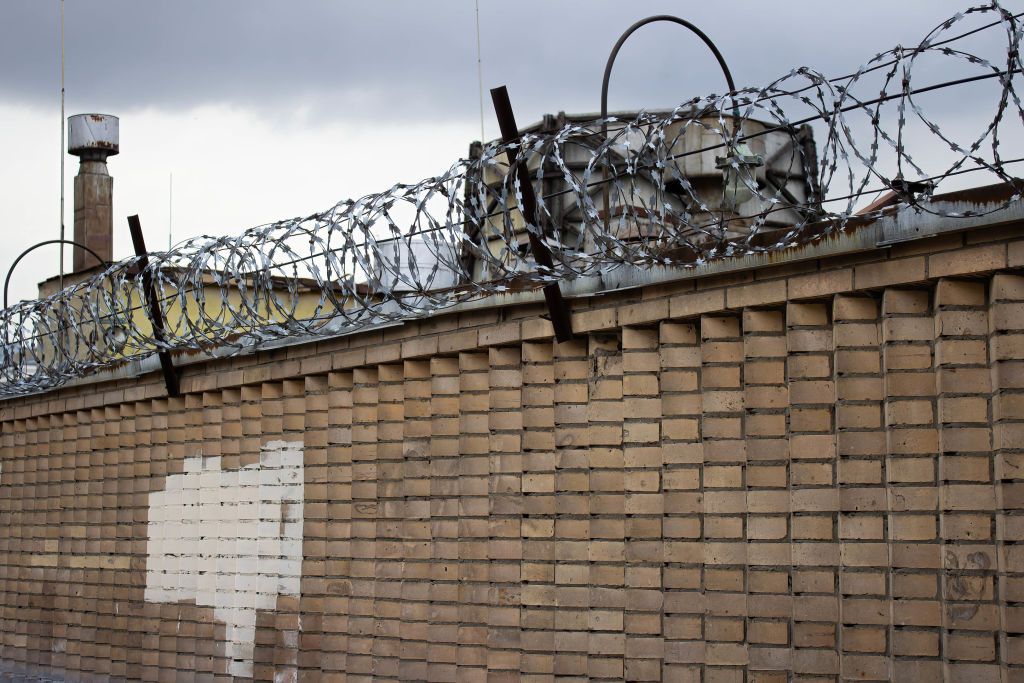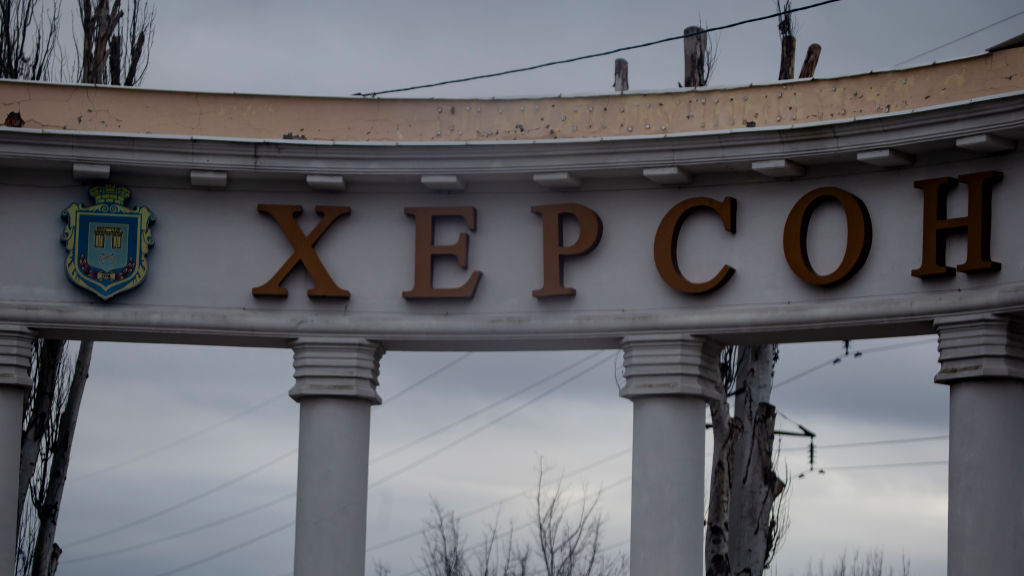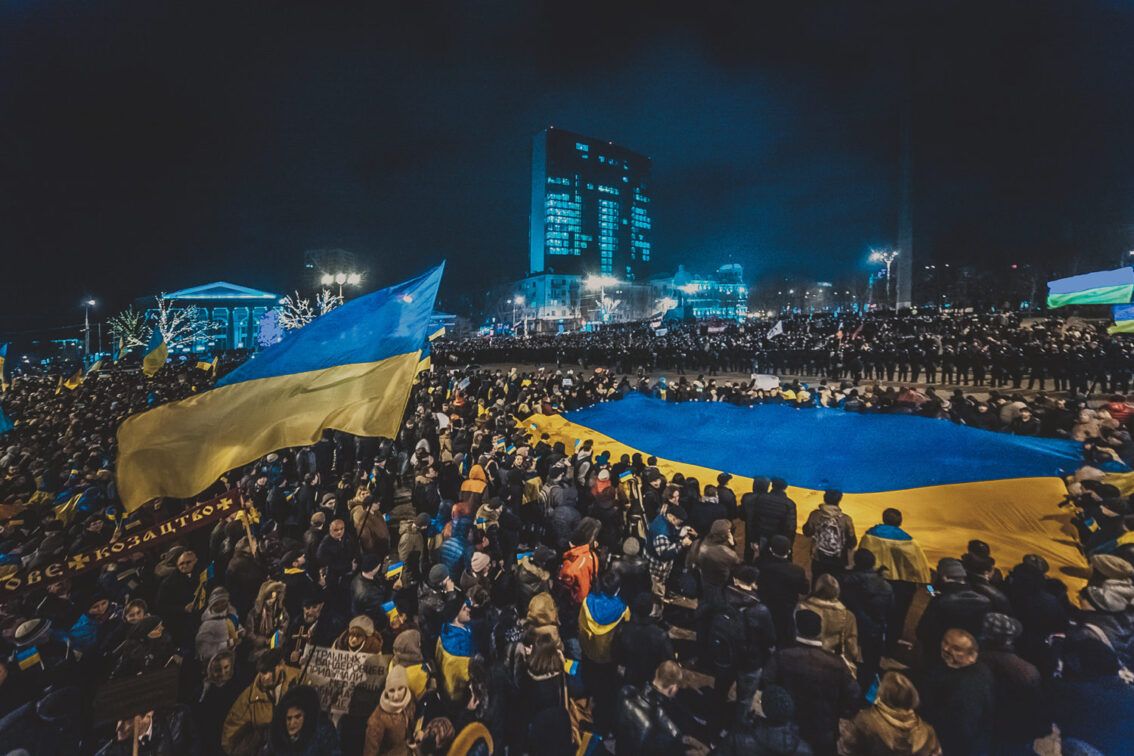Inside occupied Ukraine’s most effective resistance movements

Acts of resistance come in many shapes and sizes.
From a colored ribbon tied to a tree or a flag raised over a remote mountain face, to a quick tip-off on an encrypted app that sets off a chain of events culminating in the destruction of a warship, everything counts.
However big or small, whether the impact is military or symbolic, the actions of Ukrainians living in Russian-occupied territories over almost two years of full-scale war have all worked to drive one simple message home: that Russia’s grip on parts of Ukraine is as weak as it is temporary.
Around a fifth of Ukraine is occupied by Russian forces as of January 2024, most of which lies within five regions — Kherson, Zaporizhzhia, Luhansk, and Donetsk oblasts, where Moscow held sham referendums on joining Russia in autumn 2022 — and Crimea, which Russia illegally annexed back in 2014.

The Kyiv Independent spoke to three individuals involved in coordinating resistance operations in Ukraine’s occupied territories: representatives of well-known movements Yellow Ribbon and Atesh, as well as a Ukrainian special forces soldier specializing in maintaining a personal network of informants in Donetsk Oblast.
Each subject pursues goals with different methods: some more symbolic, some more subtle, and some more destructive. What unites them all, together with the driven Ukrainians that they work with in the occupied territories, is an unrelenting resolve to continue to resist Russian rule despite the grave personal risk.
Within Ukraine and among its backers abroad, the arrival of 2024 and the approaching two-year anniversary of the full-scale war has brought with it a widely-held sense of anxiety. Top officials have all but admitted that no quick breakthrough to once again liberate large amounts of territory will be possible for the foreseeable future, with discussion instead shifting to defending against renewed Russian efforts to take more Ukrainian land.
But according to those helping them to resist, the will of Ukrainians under occupation to be liberated has not in any way faded, and neither have their resistance operations.
Web of whispers
It has been almost 10 years since the regional capital of Donetsk was first overrun by Russian proxy forces. Even now though, the large industrial city, sitting at the heart of Russia’s propaganda claim to the lands of the Donbas region, is not a safe place for Russian soldiers.
Despite some Russian gains in the area, the city remains within the range of Ukrainian artillery, but the bigger threat is not the guns – it’s the locals. Working through contact networks based on personal trust, many unassuming Donetsk residents regularly pass on information on Russian movements to the Ukrainian military.
One such network is coordinated by Dmytro (Editor’s Note: The subject’s name has been changed to protect his informants’ identities), a native of Lyman in northern Donetsk Oblast who has served in Ukraine’s Special Operations Forces since the first months of the full-scale invasion.

When given the opportunity, Dmytro’s contacts in Donetsk and surrounding settlements tip him off about the location or movement of Russian troops and heavy equipment, which he quickly passes to Ukrainian artillery and precision-guided rocket units to deliver a strike.
His informants come from diverse backgrounds, often hardly fitting the mold of an average patriotic Ukrainian.
“We have all kinds of people, even people who have never been on Ukrainian-controlled territory (since 2014), people who once always voted for the (pro-Russian) Party of Regions, or people who haven't read anything in Ukrainian since their school textbook in the 1980s,” he told the Kyiv Independent.
“It doesn't matter, they are our eyes now.”
Dmytro is one of several such service members specializing in this kind of work, each with their own separate individual contacts. For security purposes, communication is carried out vertically only, as links between informants on the ground can increase the risk of them all being caught at once.
“People often imagine partisan movements as something out of World War II films, but there (in Donetsk) there is nothing like that, because if they catch one person then everyone is compromised,” he said.
Dmytro’s first brush with Russian aggression came right at the beginning; he had only just defended his dissertation in history at a university in Donetsk when Russian proxies took the city under the guise of a local separatist rebellion in the spring of 2014. After fighting in a volunteer battle over the first year of the war in Donbas, he returned to civilian life in Ukraine-controlled territory but did not break ties with those stranded under occupation in his former home.
“I maintained contact with the occupation all these eight years, I tried to get information out of there the whole time,” he said. “There was a period in time when our people who lived there would hang up flags, paint pro-Ukrainian graffiti, and I would write about it on my social media every now and then.”
“I wanted to counter the popular narrative in Ukraine that there were none of our people left in these (occupied) places, so I would show that there were actually many of them, and that they are resisting as much as they can.”
According to Dmytro, recent Ukrainian setbacks and fading hopes of quick liberation do not change his informants’ fundamental mission in their eyes.
“To put it philosophically, in situations like this people always ask themselves: 'Who am I?' he said. “For these people, over nine years the answer has been very clear inside of them: they are Ukrainians.”
“A real Ukrainian then asks themselves the next question: what can I do for victory? One Ukrainian is loading the shell, and another is providing the information that decides where it flies.”
Spreading fire
Over 2023, as the front line in Ukraine moved less and less in either direction, attention shifted to Crimea, where a series of Ukrainian long-range strikes exposed the vulnerability of Russia’s once secure hold on the Black Sea region.
The most dramatic of these came in September, when a Russian landing ship and submarine were destroyed in their docks in occupied Sevastopol; an embarrassing blow to receive from a country without a properly functioning navy.
Just 10 days later, the headquarters of Russia’s famous Black Sea Fleet in Sevastopol was devastated by Ukrainian Storm Shadow-type missiles during a meeting of the high command, allegedly killing 34 officers.
While the missiles were launched from Ukraine, the strikes were claimed to be coordinated by Atesh, a mysterious Ukrainian resistance organization that grew from scratch to build a feared presence not only in the occupied parts of Ukraine, but also in Russia itself.
“We provided them with a lot of assistance in reconnaissance directly from the ground,” said an Atesh coordinator going by the callsign “Sudak” about the Sevastopol strikes in exclusive comments to the Kyiv Independent.
“We have people both inside the Black Sea Fleet headquarters and outside in the form of many ordinary citizens of Sevastopol.”

Founded in September 2022, the movement, named after the Crimean Tatar word for fire, now boasts 1,800 members, 500 of which are regularly active in its operations, Sudak said.
Now, the group engages in a plethora of resistance activity, from the kind of intelligence gathering similar to that carried out by Dmytro’s informants, to information campaigns, to assorted acts of direct partisan action.
Notably, much of Atesh’s work attempts to directly engage Russians themselves, both military and civilian, with active operations in cities deep inside the Russian Federation.
“Residents of Russian cities see the physical presence of Atesh,” said Sudak. “Many Russians are tired of Putin's regime and the criminal war against Ukraine and are actively seeking cooperation.”
“We manage to recruit people in (Russian) city administrations,” said Sudak. “In addition, we attract the (Russian) military to cooperate with us. These could be mobilized soldiers, contract servicemen, or conscripts.”
In February last year, the group claimed to have attracted over 4,000 Russian service members to its “ATESH School,” a platform with videos showing how to sabotage and disable one’s own armored vehicles.
According to Sudak, who himself is a native of Crimea who chose to stay after the annexation, Atesh’s informant network extends to the highest ranks of the local Russian military system.
“The military officer has been passing us various information; about the movements of the command, personal information about other military officers, and about the general activities of the command of which he is aware.”




The group’s operations, involving both locals and Russian soldiers in occupied territories, are forcing the Russian command to take note.
“In Crimea, where we are very active, the number of FSB (Russian Federal Security Service) task forces that deal exclusively with the pro-Ukrainian underground has increased,” he said. “We have received a number of reports that city administrations are teaching employees of schools, hospitals, and other state enterprises about the unacceptability of working with Atesh.”
Although the culmination of the southern counteroffensive leaves Ukrainian forces still far away from nearing Crimea or liberating the rest of the occupied territories, Sudak is confident in a year of successful operations to come.
“We are growing tirelessly and our capabilities are growing along with it,” he said. “We are energized for active work in the new year, we have plans and desire to work even more actively for the liberation of Ukraine.”
“Our people have no doubt in victory; there is no other option.”
Not forgotten
Even when active resistance doesn’t involve the destruction of high-value military targets, even the smallest gestures can be impactful when carried out in large numbers.
For Ivan, co-founder and coordinator of the Yellow Ribbon civil resistance movement, this was already clear in the very first weeks of the full-scale invasion, when he and his colleagues were caught in Russian-occupied Kherson.
In resolute defiance of Russia’s capture of their city, Kherson residents protested en masse in the streets, but the demonstrations were soon put down by arrests, tear gas, and gunfire from Russian forces.
“I had a lot of friends from Donetsk and Luhansk oblasts who said that after the occupation in 2014, thoughts about Ukraine slowly disappeared for many people,” said Ivan, whose full identity is not disclosed for security concerns, to the Kyiv Independent. “We didn't want the same for Kherson.”
The initial idea for Yellow Ribbon was simple: to make acts of resistance as simple, safe, and accessible as possible for ordinary citizens.
Photos of yellow ribbons tied up all over Kherson quickly drew national attention, and in no time at all, the co-founders realized that they had created a working model for all of occupied Ukraine to follow.
“Everything started with us two,” Ivan said, “and when we saw hundreds of people start to join (Yellow Ribbon communities on Telegram) from different regions, we knew we couldn’t do it on our own.”
Kherson was eventually liberated by the Ukrainian military in November 2022, but the group’s activities in the rest of the occupied territories have only grown further.
By now, the movement has 12 coordinators in larger occupied cities, and a community of over 12,000 active users of its Telegram chatbot, where Yellow Ribbon shares advice on non-violent resistance, cyber-security, and legal issues. Launched in the spring of last year, a separate chatbot also allows residents to upload evidence and testimonies of Russian war crimes.

With Yellow Ribbon’s rapid growth came new responsibility and new danger, both to the individuals involved and to the movement, as Russian internal security services have ramped up countermeasures in response.
“The biggest threat now is that both the FSB and Interior Ministry, often in competition with each other, have really begun hunting people,” Ivan said. “They are looking to arrest more and more people, some on ‘terrorism’ charges, some for ‘extremism,’ and some for ‘discreditation of the army’.”
“They arrest you not because you belong to some kind of resistance group, but simply because you are Ukrainian, because somebody said you raised a Ukrainian flag somewhere even when you didn't, and because of this you are held and beaten for three months in a basement somewhere.”
Thanks to its simplicity and compelling visual language, the Yellow Ribbon movement wages its own war — more symbolic but no less important than one of artillery and missile strikes — on three crucial fronts.
Firstly, in the minds of the participants themselves: “These people have been fighting occupation, they know that sooner or later they will be liberated, if it turns out to be later, they are mentally prepared for that but otherwise it doesn't change anything else,” Ivan said. “But this symbolism is critical to remind them that they are on this path; the path to liberation, to Ukraine.”
According to Ivan, the most active base of Yellow Ribbon followers is, remarkably, in Crimea, despite already living for almost 10 years of uninterrupted Russian occupation.
“We have people as young as 18, who were nine when their homes were occupied,” he recalled.
“How did they learn the Ukrainian language? I don't know, but they use it perfectly. Some of them say their parents are pro-Russian, but they still want to do what they can for Ukraine to return.”
This presence, Ivan said, is also crucial for reminding society in Ukrainian-controlled territory that their people are waiting, and should not be abandoned by a hypothetical future peace deal.
“On Ukrainian Flag Day, for example, the Presidential Office published a photo of how we raised the flag on Boiko Mountain (in Crimea),” he said, and those involved were shocked to see the support and recognition they got.”

Finally, Yellow Ribbon, which was given special recognition within the awarding of the Sakharov Human Rights Prize to the Ukrainian people last year, has helped amplify the voices of Ukrainians under occupation all the way to the world stage.
“We show them, look, European politicians are seeing this, and now there is a new sanctions package being passed... they can feel the direct effect of what they are doing,” said Ivan.
“This reminds our people in occupation that they have not been forgotten or abandoned, which is exactly the narrative that Russia tries to push on them.”
Note from the author:
Hi, this is Francis Farrell, cheers for reading this article. We are entering a new phase of the war, which could potentially be stranger, tougher, and more uncertain than it has ever been so far. In a time when instability around the world is growing, and attention is fading when it is needed the most, please consider supporting our reporting.
















